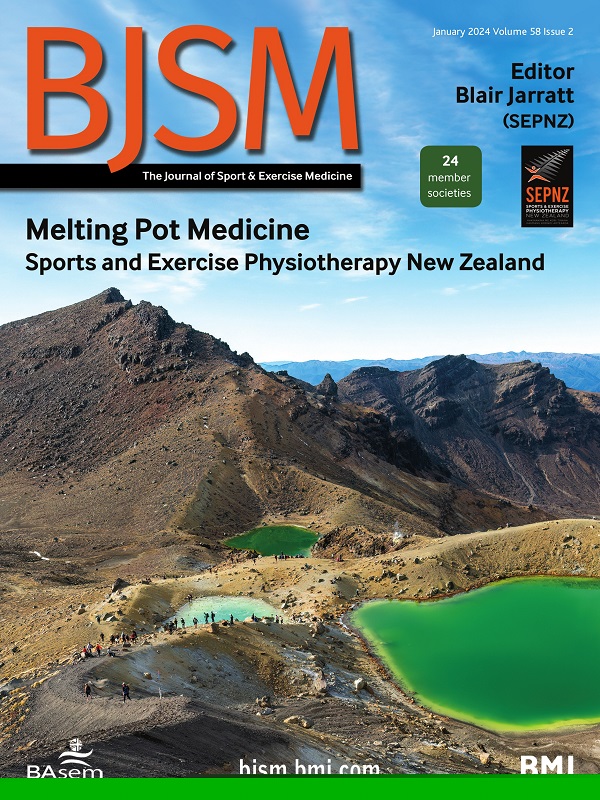运动中的相对能量缺乏症(REDs):理疗师的作用
IF 11.6
1区 医学
Q1 SPORT SCIENCES
引用次数: 0
摘要
2018 年至 2022 年间,有关运动中相对能量缺乏症(REDs)的知识显著增加,在此期间共发表了 170 多篇原创文章。国际奥委会(IOC)关于 REDs 的最新共识声明于 2023 年发表在《英国运动医学杂志》(British Journal of Sports Medicine)的专版上,并附有 10 篇叙述性评论和社论1:图 1 REDs 健康概念模型。LEA 的影响是连续的。有些 LEA 的影响是轻微和短暂的,称为适应性 LEA(白色箭头),而有问题的 LEA 则与各种不良 REDs 结果相关(红色箭头)。*心理健康问题可能发生在 REDs 之前,也可能是 REDs 的结果。LEA,低能量可用性;REDs,运动中的相对能量缺乏。正如共识声明中所建议的,在管理 REDs 时,采用多学科方法至关重要。1 多学科运动员健康与运动表现团队成员应了解 REDs 相关科学知识,并具备识别和治疗 REDs 的临床能力。Gillbanks 等人发现,物理治疗师对 REDs 的体征或症状缺乏警惕性,同时也缺乏...本文章由计算机程序翻译,如有差异,请以英文原文为准。
Relative energy deficiency in sport (REDs): the role of the physiotherapist
Knowledge of relative energy deficiency in sport (REDs) has grown significantly between 2018 and 2022 with over 170 original publications in this period. The latest International Olympic Committee (IOC) consensus statement on REDs was published in 2023 in the British Journal of Sports Medicine in a dedicated edition with 10 accompanying narrative reviews and editorials.1 The 2023 IOC REDs consensus statement includes the following: Figure 1 REDs health conceptual model. The effects of LEA exist on a continuum. While some exposure to LEA is mild and transient termed adaptable LEA (arrow depicted in white), problematic LEA is associated with a variety of adverse REDs outcomes (arrow depicted in red). *Mental health issues can either precede REDs or be the result of REDs. LEA, low energy availability; REDs, relative energy deficiency in sport. As recommended in the consensus statement, a multidisciplinary approach is essential when managing REDs. This includes the creation of a safe and trusting therapeutic relationship, which includes active listening and the prioritisation of holistic care.1 Members of the multidisciplinary athlete health and performance team should be knowledgeable in REDs-related science and have clinical competence in the recognition and treatment of REDs. Gillbanks et al identified a lack of vigilance for the signs or symptoms of REDs among physiotherapists, as well …
求助全文
通过发布文献求助,成功后即可免费获取论文全文。
去求助
来源期刊
CiteScore
27.10
自引率
4.90%
发文量
217
审稿时长
3-8 weeks
期刊介绍:
The British Journal of Sports Medicine (BJSM) is a dynamic platform that presents groundbreaking research, thought-provoking reviews, and meaningful discussions on sport and exercise medicine. Our focus encompasses various clinically-relevant aspects such as physiotherapy, physical therapy, and rehabilitation. With an aim to foster innovation, education, and knowledge translation, we strive to bridge the gap between research and practical implementation in the field. Our multi-media approach, including web, print, video, and audio resources, along with our active presence on social media, connects a global community of healthcare professionals dedicated to treating active individuals.

 求助内容:
求助内容: 应助结果提醒方式:
应助结果提醒方式:


